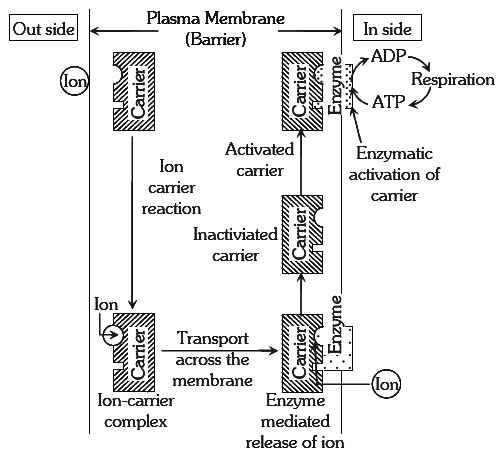- Books Name
- ACME SMART COACHING Biology Book
- Publication
- ACME SMART PUBLICATION
- Course
- CBSE Class 11
- Subject
- Biology
Absorption of elements
Minerals are mainly absorb by the root which is in direct contact with the soil solution.
Maximum mineral absorption occurs through zone of cell elongation.
The process of absorption can be demarcated into two main phases.
In the first phase, an initial rapid uptake of ions into the 'free space' or 'outer space' of cell -the apoplast, is passive.
In the second phase of uptake, the ions are taken in slowly into the 'inner space' –the symplast of the cells.
The symplast movement requires metabolic energy, i.e., it is an active process.
The movement of dissolved substances into and out of cell is called transport or flux.
Many theories have been given to explain the mechanism of mineral salt absorption.
These theories can be grouped into following two categories:
(1) Passive mineral absorption
(2) Active mineral absorption
(1) Passive absorption
Absorption of ions without use of metabolic energy is known as passive absorption.
Molecules or ions diffuse from a region bf their higher concentration to a region of their lower concentration.
The movement of mineral ions into root cells as a result of diffusion is called passive absorption.
Main theories for passive absorption are described below:
(a) Ion exchange: This theory was proposed by Jenny and Overstreet (1938). Exchange of anions and cations absorbed on colloidal fraction of the soil (clay and humus) with the ions adsorbed on root surface is referred to as ion exchange.
(i) Contact Exchange : This is based on the ion exchange from one adsorbent to another without the participation of free electrolyte. An ion which is adsorbed electrostatically to a solid particle is not tightly bound, but oscillate within a small volume of space. This is termed oscillation volume. According to this concept, H+ ions exchange with the cations and OH– ions exchange with anions.
(ii) Carbonic acid exchange: CO2 is released by root respiration, which forms carbonic acid when dissolved in soil water. This carbonic acid dissociate into H+ and HCO3– ions. Released H+ ions exchange with cations and HCO3– ions exchange with anions.
(b) Donnan equilibrium: This mechanism was proposed by Donnan (1911). Entry of ions into the cell across the plasma membrane to maintain electrical equilibrium is called Donnan equilibrium. Some anions or cations get firmly attached to the inner surface of plasma membrane (fixed and non-diffusible ions). To neutralise these, ions of opposite charges gain entrance in the cell passively (against concentration gradient i.e., without energy expenditure).
(c) Mass flow or Bulk Flow Theory. According to Hylmo, the ion absorption increases with increase in transpiration. The ions have been considered to move in mass with flow of water from the soil solution through the root and eventually to the shoot.
Active mineral absorption
The absorption of ions, involving use of metabolic energy is called active absorption. This occurs against the concentration gradient. Energy used in this mechanism comes from metabolic activities, especially respiration.

(a) Carrier Concept : This concept was proposed by Van den Honert. According to this concept, there are separate protein carriers for cations and anions. The carrier forms an ion-carrier complex on the outer face of the membrane. This complex dissociates and releases ions into inner-space. The inactivated carrier is again activated by the enzyme kinase. In this process ATP is used up, this activated carrier again accepts new ions and entire cycle is repeated.
(b) Cytochrome Pump Hypothesis - It was proposed by Lundegardh and Burstrom. This gates that anions are absorbed actively and cations passively. At the outer surface of membrane, cytochrome loses an electron durin oxidation and picks up an anion in exchange. It is then transported to the inner side of the membrane through the-cytochrome chain. The cations move passively along the electrical gradient created by the accumulation of anions at the inner surface of membrane. The increased rate of respiration upon anion intake is called as salt respiration.
(c) Protein Lecithin Theory : Proposed by Bennet and Clark. They observed that a phospholipid called lecithin is involved .in transport of ions and act as carrier. The lecithn is composed of phosphatidic acid and choline. Phosphate group in phosphatidic acid is regarded as e active cation binding center and choline is anion binder. These ions are liberated on the inner surface of the membrane by catalysis of lecithin presence of enzyme lecithinase. The regeneration of lecithin from phosphatidic acid and choline occurs in presence of choline acetylase, choline esterase and ATP.

 ACME SMART PUBLICATION
ACME SMART PUBLICATION
